
Modem installations are often damaged by lightning-induced overvoltages if they are connected to networks with overhead lines. In tropical Brazil, lightning has caused great damage to data transmission modems in the past. To overcome this, telco carrier Telefonica decided to develop a compact protection module using components from Epcos.
Telefonica operates a large installed base of about 85 000 modems for data communications. They operate with transmission rates from 2,4 to 64 Kbps, mostly run in a four-wire configuration (half duplex).
Modems must comply with the NET 001/92 standard, which specifies a 600 V, 10/700 µs surge test applied in differential mode as well as a dielectric strength test in common mode with 500 V a.c.
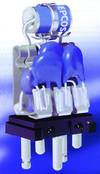
Preliminary tests for the protective equipment were performed in conjunction with the CPqD Foundation. It defined the required degree of protection on the basis of the electromagnetic susceptibility of the existing modems and the requirements of international standards ITU-T Rec. K.21 and IEC 1000-4-5.
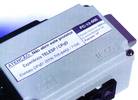
Extensive simulation through laboratory tests
The modem under test was connected to an artificial telecommunications line corresponding to 5 km of paired cable. The surge generator (Figure 3) emitted its energy to the feed voltage of the modem via a 150 V varistor used as a coupler and located close to the protective module and thus to the modem. The performance of the modem was tested with a bit-error rate tester before and after application of the surges. The use of varistors instead of capacitors (as specified by the IEC standard) complies with the method based on ITU-T SG-5 and is justified by the fact that the specified capacitor greatly attenuates the energy supplied to the ports under test. This means that varistors are better suited for this purpose.
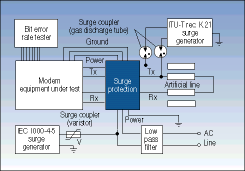
The generator and the procedure for testing the telecommunications ports (Tx and Rx terminals) were derived from ITU-T Rec. K.21, and the charging voltage was 4,0 kV. The coupling between the generator and the telecommunications line was set up by a 230 V gas discharge tube (GDT).
Both the generator and the procedure for testing the power ports were derived from IEC standard 1000-4-5, which specifies a charging voltage of 4,0 kV for common-mode and 2,0 kV for differential-mode surges.
The strategy for testing the protective modules was based on a three-stage protective configuration of components designed to reduce the interference level to voltages which would not damage the modem.
The following components were tested for the power port:
* Metal oxide varistors.
* Isolating transformers.
* Common-mode chokes (series inductances).
The following components were tested for the telecommunications port:
* Gas discharge tubes.
* Self-triggered thyristors.
* Zener diodes.
* Matching resistors.
* Metal oxide varistors.
* Common-mode chokes.
* Isolating transformers.
If it became necessary to insert a series impedance between two stages, resistors were selected instead of inductances so that matching could be performed independently of the wave form of the surge voltage.
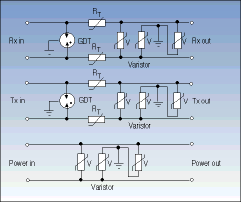
Components selected for protective module
The circuit diagram of the protective module is shown in Figure 4. A stage comprising a set of SIOV metal oxide varistors in a delta array (phase/zero and phase/phase) was sufficient to protect the power port. After a series of laboratory tests had been conducted, the most effective protection equipment for the telecommunications ports (Tx and Rx) was implemented in two stages with a series impedance for matching between them. For the telecom ports, the first stage consisted of a surge arrester in the form of a GDT with three electrodes, and the second stage of metal oxide varistors in a delta array. A series resistor designed for matching was connected between the two stages. In order to comply with the other tests to ITU-T Rec. K.21, the series resistors were replaced by PTC thermistors designed to open the circuit during the power induction test.
The selection of components was made somewhat more difficult by Telefonica's requirement for a single protective component for all applications. The protective module was thus developed in only two versions with different line voltages: 127 or 220 V. All the protective devices used (GDT, PTC thermistors and varistors) are standard components manufactured by EPCOS.
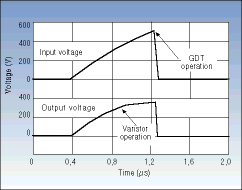
Characteristics and performance of protective modules
The two-stage protection of the telecommunications line permits three protective functions to be implemented against overvoltages caused by lightning strikes:
The first is the combination of high-energy gas-filled arresters with fast-acting varistors. The effect of this configuration on the voltage attenuation when a standard surge of 4 kV, 10/700 µs is applied to the inputs is shown in Graph 1. Because of the time required for the gas ionisation and the rise rate of the voltage, the arrester is operated at 520 V. Before the arrester comes into play, the varistor limits the output voltage to 340 V and thus dissipates energy for a short time. The difference between input and output voltages is applied to the PTC thermistor.
The second protective function is provided by the differential mode varistor, which limits any overvoltages.
The third protective function is provided by the low-pass filter created as a by-product by the resistance of the PTC thermistor in series with the capacitance of the varistor.
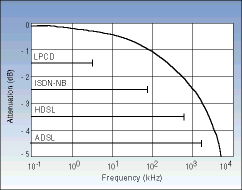
Effect of protective module on transmission characteristics
An important aspect of the protective module is its effect on transmission characteristics. This can be calculated on the basis of the insertion loss (Pi) in dB defined in the channel due to the insertion of the protective module Graph 2. The frequency bandwidth required by the most widely used modem technologies can also be derived from this diagram. The standard modem operates in the voice band. The protection tests were conducted with this modem type. The other modem types are shown in Graph 2 purely for comparative purposes.
It can be seen from the diagram that the insertion loss of the protective module is negligible in the voice band (below -0,3 dB) and that it affects modems operating at higher bit rates to an acceptable extent as a function of the loss of each individual line. In the low-frequency range, the attenuation is due principally to the resistance of the thermistor. It can thus be reduced by selecting a PTC thermistor with a lower resistance, assuming that the matching function is maintained. The attenuation in the higher frequencies is caused by the filter effect of the thermistor's resistance, the varistor's capacitance and the reduced line impedance at higher frequencies.
Field trials
For the trials, Telefonica selected 15 modem lines with a high failure rate. These lines had an average modem damage rate of 0,36 defects per line and month, which corresponds to a failure of about one modem every three months per line. The main indication that these failures were linked to voltage surges induced by lightning discharges was their increase during the thunderstorm season (December to March). After installation of the protective modules, no more lightning-induced damage problems occurred in the entire region.
Summary
Lightning can destroy modems and other terminals connected to overhead lines. Safety circuits are thus indispensable to undisturbed data transfer. Suitable protective modules matched to all regional conditions can be developed from surge arresters, varistors, inductors and capacitors.
| Tel: | +27 11 458 9000 |
| Fax: | +27 11 458 9034/5 |
| Email: | [email protected] |
| www: | www.electrocomp.co.za |
| Articles: | More information and articles about Electrocomp |
© Technews Publishing (Pty) Ltd | All Rights Reserved